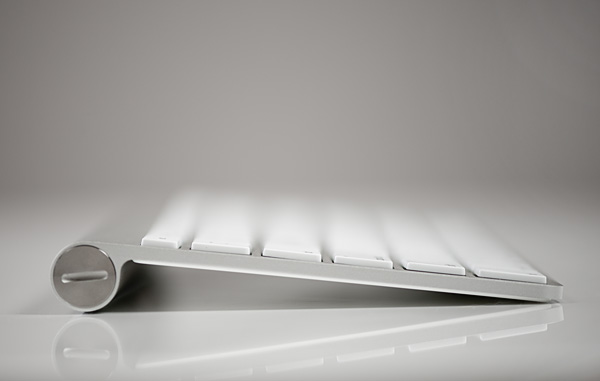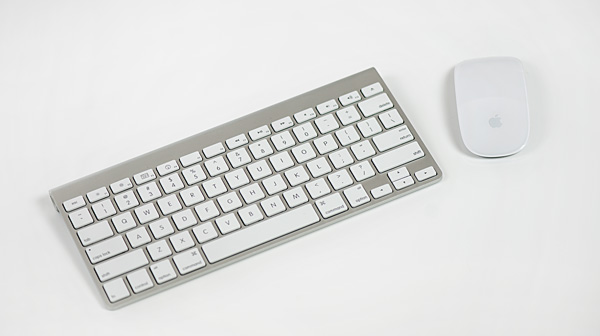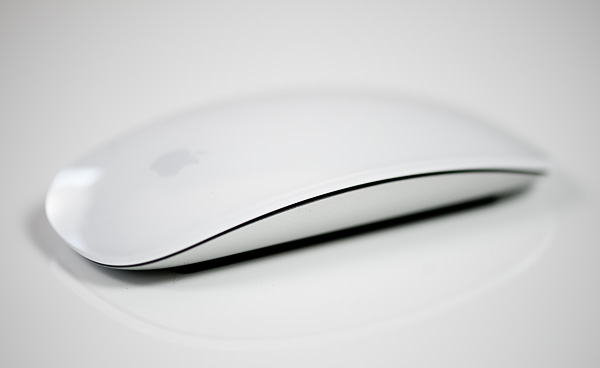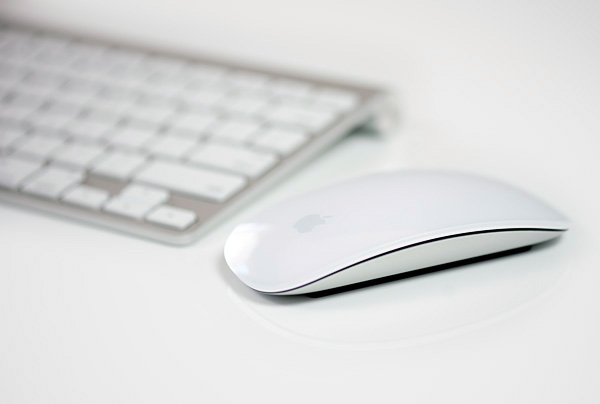The 27-inch Apple iMac Review (2011)
by Anand Lal Shimpi on May 27, 2011 2:30 AM ESTThe Peripherals
I've never been a fan of wireless peripherals - I didn't want more things to charge. Last year I finally broke down and bought a wireless mouse: Microsoft's Wireless Mobile Mouse 4000. I didn't buy it for mobility, I just liked the form factor.
The iMac comes with all wireless peripherals. In fact, if you stick with WiFi for network access, there's only a single cable you need going to the iMac: power. By default you get Apple's Wireless Keyboard and a Magic Mouse.
The Wireless Keyboard is a Bluetooth keyboard that runs off of two AA batteries. It pairs effortlessly with the iMac and I didn't encounter any issues with interference in using it. The keyboard seems to burn through batteries quicker than the mouse, perhaps that's because I type far too much or there's an issue with power management under OS X. After a week of use I'm down to 81% on a fresh pair of batteries (this is my second set).
The keyboard itself is a lot like Apple's standard aluminum keyboard, just wireless and more compact. Apple chopped off the dedicated home/end key island as well as the numeric keypad. Under OS X Cmd + Left/Right Arrow take the place of Home/End for me so part of the sacrifice isn't a problem, but the missing numeric keypad is. I do entirely too much data entry (ahem, benchmarks) to not have a dedicated numeric keypad, and for some reason Apple doesn't offer the Wireless Keyboard with one.
If you don't type tons of numbers every day however, the Wireless Keyboard is really nice. Apple had to stick a function key to the left of the control key, which is a bit bothersome (leave my control/option/cmd row alone) but it's nothing you can't get used to. The footprint is great. I have a giant desk, but I always seem to run out of desk space. The Wireless Keyboard makes it so that I can reclaim a small amount of high value desk area.
Typing feel and keyboard angle are both great - no complaints there. I'm a fan of Apple's keyboards.
Pointing devices designed in Cupertino are another story entirely. I've never liked Apple's mice. It was a big enough problem that when I first tried my Month with a Mac experience I ditched Apple's mouse. There was no way I was going to give the platform a fair shake if I had to use that thing. Since then Apple has at least enabled double clicking - the surface of the Magic Mouse is touch sensitive, click with your right finger and you get a right click. The Magic Mouse has no scroll wheel but drag your finger around on its surface and you get the best scrolling experience on a physical mouse.
The Magic Mouse is also a Bluetooth device that quickly pairs with the iMac. I noticed under Windows there's always a second or two of lag before it recognizes the mouse whereas it's useable as soon as you can see it under OS X.
My complaints about the Magic Mouse are three-fold. As I've mentioned before, the Magic Mouse doesn't have soft rubber feet that glide around on your desk. Instead you get two hard plastic strips that just seem to scrape against all surfaces. Tracking isn't a problem, but it's not a pleasant experience.
The other issue I have is the form factor itself. Microsoft's Wireless Mobile Mouse 4000 is small but it has a nice curve to it that seems to match my hand very well. The Magic Mouse on the other hand doesn't conform to any part of my body. I can lay my hand flat on it but either I'm not conditioned to do that or that's not a very comfortable way to use the mouse for long periods of a time.
Finally there's the clicking noise it makes. Modern mice seem to have a solid but more muted click, whereas the sharp click of the Magic Mouse reminds me of the past decade of Apple mice. I assume that's what Apple was going for, but Apple's market share has grown considerably in the past 10 years - it's ok to let go of some traditions.
Apple does offer the Magic Trackpad as a no-cost option. I have a love/hate relationship with the Magic Trackpad as a pointing device. Scrolling and gestures are great on it, but I prefer a normal mouse for most everything else.
















139 Comments
View All Comments
Spazweasel - Friday, May 27, 2011 - link
Thanks for the clarification.Spazweasel - Friday, May 27, 2011 - link
So here's a question. While the display is in Targeted Display Mode, can the computer itself be active? It would be nice to be able to have the computer available for computation tasks, acting as a server, etc. on its own while the display was being used by an external device. I wouldn't expect it to be so, but perhaps you as someone with first-hand knowledge would know if it's possible.Thanks!
KoolAidMan1 - Friday, May 27, 2011 - link
Yes, the computer portion of the iMac can still be cranking away when the video signal is switched to another source. I've had it encoding video as I play Starcraft 2 or whatever on my PC, using the iMac as its display.It is pretty nice.
archer75 - Friday, May 27, 2011 - link
So I bought one of these imacs right at launch. Upgraded the processor to the 3.4ghz i7 and got the 6970m 2gb. Later got 16gb of ram on sale at newegg.In terms of gaming I only play at native resolution 2560x1440 and must say this imac does slightly better than my i7 920, 460GTX 768mb PC does at 1920x1200.
Crysis 2 on medium settings gives me frame rates in the 30-50 range which is perfectly fine for me. Medium doesn't look any different than high to me so i'm happy with that. Very smooth gameplay with Bad Company 2 and Portal 2. WoW on ultra settings is flawless. Civ5 plays well. Age of Conan at max is pretty smooth, not perfect but certainly better than my gaming PC. EQ2 runs very well at one step down from their super high ultra setting or whatever they call it. Running max settings with Dragon Age.
I have 7 other PC's in the house, 4 running Win7, 1 running WHS 2011 and the 2 others running XP. I built most of them. And I had debated building another gaming system or getting the imac and decided to mix things up a bit and must say I really do like the imac.
Bob Forsberg - Friday, May 27, 2011 - link
Just about ready to purchase a new 27" iMac to replace my white 24" 2.16GHz iMac from 4 years ago.You made choices easy on processor types as well as providing answers to many of my questions. Thanks for the thorough analysis of this great machine.
CharonPDX - Friday, May 27, 2011 - link
"I've always kept displays through several upgrades, but you can't really do that with an iMac."One thing Apple has implemented on their 27" iMacs since they added Mini DisplayPort is that you can use the iMac as a DisplayPort monitor.
So when this iMac gets replaced, you can continue to use it as a 27" display on another computer with DisplayPort video. Be that another iMac (and have two displays), a Mac Pro, a Mac mini, or even a PC with DisplayPort (as most Dells have now.)
I know a customer that has two last-gen iMacs side-by-side: One as his workstation and one as a secondary display and VM host. He interacts with the VMs remotely from the 'workstation' machine, and has two 27" high-res displays on his primary system. If he ever really needs to interact locally with the VM machine, he just plugs a keyboard and mouse directly (although he generally VNCs over.)
tipoo - Friday, May 27, 2011 - link
Actually these new ones will only work with Thunderbolt, not DP unfortunately. So for now, just the Macbook Pro's can use it. The last gen could work with any displayport connection so its a step back IMO.tipoo - Friday, May 27, 2011 - link
I'd really like a decibel reading for a few computers in future reviews. ie, you say the MBP is loud, but how loud? I'd like to see it compared to other popular laptops at idle and under load.Hubb1e - Friday, May 27, 2011 - link
To understand an iMac usage model, you have to get over your idea that you upgrade your PC components. When you outgrow the GPU, you simply upgrade the whole Mac and sell the old one on the used market. The used market for these things is huge so you really aren't dropping much cash by ditching the old model for a new one. You aren't really ditching the monitor, you're simply making an upgrade for the GPU and a new screen comes with the upgrade. It's typically a sideways move in screen quality and you aren't losing any real value there by replacing it. You might drop $600 (accounting for taxes) when you drop the iMac after 1.5 years, but you get $400 worth of GPU and CPU upgrades. So, you do pay a bit for the Mac experience, but I think you can still keep the upgrade path going with a Mac.Keep the box and it's super simple to unload a used Mac.
dingetje - Saturday, May 28, 2011 - link
is there any chance of a review of some 16:10 screens? for instance ASUS PA246Q